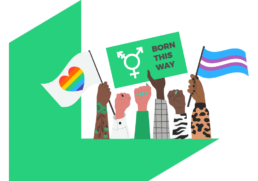
Transgender Rights' Toolkit
Transgender Rights' Toolkit
Toolkit collated by Georgie Williams with Jo Brassington
What Does Transgender Mean?
Transgender (often shortened to trans) is an umbrella term, it describes individuals whose gender identity is not entirely aligned with the gender that was assumed of them based on their birth sex. This includes transgender men and transgender women. Transgender women were assigned ‘male’ at birth, and therefore assumed to be men, but they do not identify with this assumed gender and instead identify as women. Whereas a transgender men were assigned ‘female’ at birth, and therefore assumed to be women, but they do not identify with this assumed gender and instead identify as men.
Some transgender people identify outside of the gender binary of ‘men’ or ‘women’. Often these people use terms such as nonbinary, among other terms that feel right for them. Nonbinary identities and language may be new and developing, but everybody should be able to find language that allows them to accurately and meaningfully talk about their experience of gender.
Historically, many people have fallen into using language that excludes trans people. For example, talking about two groups: transgender people, or ‘normal’ people. To avoid this, it can be useful to have a name for that second group of people who are not trans. This is why we sometimes use the word ‘cisgender’ to refer to any person whose gender identity does align with the gender they were assumed based on their birth sex. Using this word can help us to be more accurate when talking about trans people, and it acknowledges that all of us have an experience of gender. Gender is not just a trans issue.
Transgender people are legally protected from discrimination, victimisation, and harassment through The Equality Act of 2010 and we should endeavour to create safe educational spaces for them. It is statutory for all schools to ensure transgender identities are integrated into Relationships & Sex Education. Furthermore, the statutory safeguarding guidance ‘Keeping Children Safe In Education’ tells educators they should be endeavouring to reduce any additional barriers faced by trans young people, and create safe spaces for them.
Transgender women are women, transgender men are men, and nonbinary transgender people’s identities should also be respected. Allyship can ensure that transgender individuals’ identities are recognised, respected and protected.
- Acknowledging and respecting the language people use, including their name, their title, and their pronouns.
- Supporting and safeguarding transgender individuals who are at risk of discrimination and prejudice
- Creating trans-inclusive spaces e.g.: gender-neutral bathrooms
- Using gender-neutral language for groups and for individuals whose gender is not known
- Creating workplaces which support trans needs (e.g.: non-gendered dress codes, paid leave for employees undergoing transitional therapies)
- Advocating for and defending the rights of transgender peers when challenged
The Diverse Educators’ Transgender Rights Toolkit
We are collating a growing bank of resources to support you in how you show up, how you stand up and how you speak out, on matters pertaining to transgender rights and welfare.

